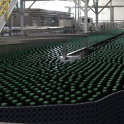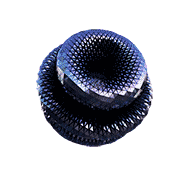|
I did a bunch of carb checks yesterday.
|
|
|
|

|
| # ? Jun 11, 2024 05:58 |
|
Yeah I'm gonna "Carb Check" my Cabernet IPA tonight. (literally though, the last one was almost flat, but it had only been 4 days)
|
|
|
|
I have an off flavor happening in a porter, the same that came up in a saison and an ipa a few months back. I got all new post-boil equipment (buckets, airlocks, hydrometer, thief, etc) and I'm scratching my head at what could be the cause. The only thing I can come up with is the 2-row that I used, which I keep in a rubbermaid in my garage (which can climb up into the 80s-90s on a warm day). It's over six months old, and I didn't have it super-sealed (no vittles vault for me yet but I'll switch over if you folks say that could be the problem), but I always nibble on a bit of the grain before using it and haven't thought "this tastes lovely" at any point. For the saison and ipa, that off flavor turned into an infection, an unmistakable/undesirable quality that I had to dump. The porter's been aging for a month in the bucket and I noticed it was still dropping in gravity in week 4...got worried and tried a bit and noticed it was much thinner than I'd hoped AND had hints of what turned into infections with the saison/ipa. I crashed the bucket to around 37° on Friday and I'm thinking if I get it off the cake and hit it with some coffee & vanilla (my original plan anyway) I might be able to stunt the onset of anything nasty on the horizon (or at least cover it up). I guess my question is, if any of you used dodgy grains and it came back to haunt you, what did that off flavor taste like? Furthermore, anyone have any ideas on what the hell else I could do to avoid these infections? I fermented the porter in a fermentation fridge in the garage, a decent distance away from where I had the saison & ipa at (in a spare unused bathroom inside the house). It's unbelievably discouraging to a) not have a whole lot of time in my life to brew as it is, but then b) have what I make end up undrinkable. HALP?!
|
|
|
|
Marshmallow Blue posted:Yeah I'm gonna "Carb Check" my Cabernet IPA tonight. (literally though, the last one was almost flat, but it had only been 4 days) gonna take way more time than that, give it a good 2 weeks to bottle condition
|
|
|
|
Marshmallow Blue posted:Yeah I'm gonna "Carb Check" my Cabernet IPA tonight. (literally though, the last one was almost flat, but it had only been 4 days) See mine had only been in there a week so it was a legitimate test, I swear.
|
|
|
|
wattershed posted:Furthermore, anyone have any ideas on what the hell else I could do to avoid these infections? I fermented the porter in a fermentation fridge in the garage, a decent distance away from where I had the saison & ipa at (in a spare unused bathroom inside the house). What are you using for chilling? If you got new buckets, etc then that's the only point I could see an infection coming in.
|
|
|
|
JawKnee posted:gonna take way more time than that, give it a good 2 weeks to bottle condition Shhhh! Don't tell my beers that, they're usually carbed in a week. Still greenish for another week, but I have all 5 gallons to myself. The 4 day one was just me being dumb, but I knew what I was getting into.
|
|
|
|
I had the best thing ever happen... I brewed a second batch of a saison I had done previously due to friends liking the first batch. I only made minor adjustments but somewhere during the process I must have screwed up royally because I tasted a bottle after a week and it was basically butter. So. Much. Diacetyl. My heart was broken. I forgot about the two cases of bottles, figuring I'd get back to dump them eventually, or maybe the diacetyl would disappear with time. Anyway, I got caught up with other projects and basically wrote it off. Cut to this morning, I'm going through my refrigerator looking for something and I notice that one of my yeast cultures is labeled wrong. Wait a second. This isn't the WLP575 that I added bacteria to in secondary. So that means the diacetyl from my previous saison several months ago might be the product of pediococcus. I just now popped a bottle and all diacetyl is gone. In it's place is a very light tartness that works beautifully. Serendipity!
|
|
|
|
Cpt.Wacky posted:What are you using for chilling? If you got new buckets, etc then that's the only point I could see an infection coming in. An IC which I put in the boil at t-10.
|
|
|
|
wattershed posted:An IC which I put in the boil at t-10. Do you have a ball valve on your kettle?
|
|
|
|
more falafel please posted:Do you have a ball valve on your kettle? Nope, at the end I just pick the whole drat thing up (I STRONG MAN) and pour through a strainer (which I made sure to buy a new one of as well!) into the bucket. AND THEN I AERATE IT WITH A STIR STICK ATTACHED TO A DRILL THAT I HAVE NOT CHANGED OH CRAP I WONDER IF THAT'S IT That seems like such a small thing with such a short period of contact but...maybe...?
|
|
|
|
wattershed posted:That seems like such a small thing with such a short period of contact but...maybe...? I've seen so many people's "infections" end up being other things I'd like to know what are the actual off flavors you're tasting? What do you do for yeast for each batch? What do you do for water for each batch? When you say the gravity on your porter keeps dropping where is it at versus where it initially stopped?
|
|
|
|
Josh Wow posted:I've seen so many people's "infections" end up being other things I'd like to know what are the actual off flavors you're tasting? What do you do for yeast for each batch? What do you do for water for each batch? When you say the gravity on your porter keeps dropping where is it at versus where it initially stopped? To be honest I kinda suck at describing off flavors. When I look at a flavor wheel, I keep coming back to "chemical-y." This is what I know, though, that I'd never had this flavor in any of the previous ~30 batches I'd done until I came across it in an IPA & Saison that were fermenting in a dark closet maybe six months back. The IPA seemed okay when I checked the gravity of it, and I checked the saison at the same time. Came back maybe 3 weeks later to rack off the IPA and there was a well-established pellicle and a distinct "that's not right" taste to it. The gravity had continued to drop, and a taste indicated it had gotten very thin, far thinner than I'd expected for the beer/yeast and thinner than any other IPA I'd done previously. The saison at the time still seemed okay, so while I dumped the IPA I kegged up the saison. Over the next two months in the keg, however, the saison progressively got worse and worse. I started to cut it 50/50 with some cider (a great combo, btw), and eventually I couldn't hide the off flavor any longer and had to dump that as well. It had the same off flavor as the IPA. For yeast, I let a starter run on a stir plate for a couple days, put into the fridge the night before the brew day, then take out an hour or so before pitching to warm up a hair. Decant as much as I can and pitch when it's time. I also use servomyces in the boil to help things along. I have relatively hard water, which for darker beers I tend to leave alone - I've really enjoyed the profile it lends to big stouts and the like - and for everything else treat with the ph 5.2 stabilizer in the mash. For the gravity, ever since I've started using servo, I've noticed these very fast, aggressive fermentations with a fairly abrupt end. I'll let everything rest and usually take my first reading after a week. For all the non-infected beers I've used servo on, it might drop another point or two (say, from 1.014 to 1.012), but that's it. For these three beers, I've gotten the usual fast fermentation followed by this steady/slower decline after that. Since this porter is still young it hasn't gone down all that much, but in a week I went from 1.082 > 1.018, and it's at 1.012 three weeks after that first reading (a month after brew day). Again, I'd have more questions than this if this were the first time I made any of these beers, or if I were trying anything new in my process. It's these last three beers that have exhibited this weird flavor and that's it. I guess I could just go scorched earth on my equipment, but I'd rather spend that money on things I don't already have or, ya know, keep it in the bank.
|
|
|
|
Jo3sh posted:Haven't been there myself, but Homebrew Heaven in Everett seems to have a good reputation. Looks like it's probably 20-25 minutes from you in Lake Stevens. What's good in Seattle?
|
|
|
|
wattershed posted:To be honest I kinda suck at describing off flavors. When I look at a flavor wheel, I keep coming back to "chemical-y." This is what I know, though, that I'd never had this flavor in any of the previous ~30 batches I'd done until I came across it in an IPA & Saison that were fermenting in a dark closet maybe six months back. The IPA seemed okay when I checked the gravity of it, and I checked the saison at the same time. Came back maybe 3 weeks later to rack off the IPA and there was a well-established pellicle and a distinct "that's not right" taste to it. The gravity had continued to drop, and a taste indicated it had gotten very thin, far thinner than I'd expected for the beer/yeast and thinner than any other IPA I'd done previously. If you're getting pellicles that's infection plain and simple. I just asked because I've seen people have chlorophenols or problems with their water filters and chalk it up to infections for several batches before actually figuring it out. Did you replace your racking cane/autosiphon/tubing? Do you make sure all your starter equipment is sanitized properly? Honestly besides hardcore sanitizing everything that touches beer post boil there's not a whole lot of advice to give.
|
|
|
|
Seph posted:I tasted my wheat beer on Thursday after being kegged and force carbed for a week. Had a strong sulfur smell and tasted a little bit sour/bitter, which was strange because I only put in 1oz of hops. I decided to purge the keg and it smelled rancid. Like someone had just taken a poo poo in my living room. Word of advice - get a hold of a short copper cool and run it between your fermentation vessel and keg when you keg anything fermented with lager or wheat yeasts. I use my old immersion chiller for mine. It seems to cut out any sulphuric smells and tastes, just make sure you run starsan through it before use 
|
|
|
|
For what it's worth, try replacing the stirring bit. Or at least bathe it in sanitiser beforehand Otherwise get into your local council for water reports - it could be overly chemically treated water? See what you can find anyway. Otherwise just bathe everything you can in acidic sanitisers, or try no chilling straight into the fermenter and allowing it to cool naturally before pitching. Other than that, without seeing the process in full it could be about dozen things lol. Yay, bacteria
|
|
|
|
A while back I think I saw at least one person recommend this thermometer to monitor mash temperature: http://www.amazon.com/dp/B00004XSC5/ref=wl_it_dp_o_pC_nS_ttl?_encoding=UTF8&colid=1KDOQ2WJKSNJC&coliid=I1UC31IMBROZST&psc=1 Looks like some of the reviews say that the probe tends to wear out quickly. Even though you wouldn't really be using this thing to measure temperatures much higher than 200 degrees, has anyone had the same experience? And would shutting the lid of a cooler over it create any issues with a seal so you'd lose heat during the mash?
|
|
|
|
Whodat Smith-Jones posted:A while back I think I saw at least one person recommend this thermometer to monitor mash temperature: I have it and it works very well for me. I've used it on about a dozen batches and use it for meat temperatures in my oven as well and I've never had any issues with it. Going strong about four or five years now.
|
|
|
|
I'm brewing this beer on Saturday, and I'm thinking about doing the coriander and orange zest option. Do I need to do anything specifically to ensure the coriander and orange zest are sterile? Will pitching them into the boiling wort and killing the burner at the same time do the trick? Or should I let the boil run for a minute or two after adding them?
|
|
|
|
McSpergin posted:Word of advice - get a hold of a short copper cool and run it between your fermentation vessel and keg when you keg anything fermented with lager or wheat yeasts. I use my old immersion chiller for mine. It seems to cut out any sulphuric smells and tastes, just make sure you run starsan through it before use Seconding this advice, it works like magic. I had a rhino farty cider and all I had to do was put my chiller in the bucket and the sulfur disappeared. Some people also cut a small piece of copper pipe and put it on the end of their siphon hose.
|
|
|
|
internet celebrity posted:Seconding this advice, it works like magic. I had a rhino farty cider and all I had to do was put my chiller in the bucket and the sulfur disappeared. Some people also cut a small piece of copper pipe and put it on the end of their siphon hose. I'll be kegging my first lager shortly so this is good to know. I might have to try the pipe on the end of the hose trick.
|
|
|
|
Whodat Smith-Jones posted:A while back I think I saw at least one person recommend this thermometer to monitor mash temperature:
|
|
|
|
Syrinxx posted:I have used those for years. The probe will eventually fail if you let it get submerged where the cable and the probe sleeve meet, because it's not completely sealed. If you just keep that part up out of the liquid it will last forever. So I guess that means you can't get the probe too far down into the mash. I was hoping to submerge it a bit deeper into the liquid in the middle of the mash tun than what I'm currently able to reach with my digital thermometer that you have to hold in your hand (can't remember what the name of it is, but it's one that a lot of people on here use). Do you just have this onesitting in the liquid around the outside of your mash tun or suspend it from the lid with some tape or something so it dips down into the middle? Is there not a huge difference between measuring temp in the middle vs the outside?
|
|
|
|
Whodat Smith-Jones posted:So I guess that means you can't get the probe too far down into the mash. I was hoping to submerge it a bit deeper into the liquid in the middle of the mash tun than what I'm currently able to reach with my digital thermometer that you have to hold in your hand (can't remember what the name of it is, but it's one that a lot of people on here use). Do you just have this onesitting in the liquid around the outside of your mash tun or suspend it from the lid with some tape or something so it dips down into the middle? Is there not a huge difference between measuring temp in the middle vs the outside? There's probably not much of a difference between the outside rim and the center, but there will probably be at least some differences between the bottom, middle, and top unless you're using a recirculation system. Couldn't you get some food grade high-temp silicone and seal it yourself?
|
|
|
|
Whodat Smith-Jones posted:So I guess that means you can't get the probe too far down into the mash. I was hoping to submerge it a bit deeper into the liquid in the middle of the mash tun than what I'm currently able to reach with my digital thermometer that you have to hold in your hand (can't remember what the name of it is, but it's one that a lot of people on here use). Do you just have this onesitting in the liquid around the outside of your mash tun or suspend it from the lid with some tape or something so it dips down into the middle? Is there not a huge difference between measuring temp in the middle vs the outside?
|
|
|
|
internet celebrity posted:Seconding this advice, it works like magic. I had a rhino farty cider and all I had to do was put my chiller in the bucket and the sulfur disappeared. Some people also cut a small piece of copper pipe and put it on the end of their siphon hose. Any thoughts on how to do this in a cider that's already kegged? The only copper I have easily usable is my IC, but I can't fit it in a keg.
|
|
|
|
Drop some pennies in the keg.
|
|
|
|
more falafel please posted:Any thoughts on how to do this in a cider that's already kegged? The only copper I have easily usable is my IC, but I can't fit it in a keg. ave another keg? Feel like rigging up some crazy poo poo? Sterilize and CO2 purge the Copper IC, hook up between beer out on both kegs CO2 --Gas In--> Current Keg --Beer Out--> Copper IC --Beer Out--> Empty Keg --PRV--> Atmosphere The Cider will transfer from one keg to the next through the IC and if copper contact is the solution to the problem, you'll have plenty of it during the transfer.
|
|
|
|
McSpergin posted:For what it's worth, try replacing the stirring bit. Or at least bathe it in sanitiser beforehand I have my local report from 2010 and 2013, and it doesn't look like much has changed. Here's 2013:  Thanks for the help, everybody. Homebrewers are always the best people.
|
|
|
|
Syrinxx posted:Yeah I wind the cord around the handle of the boil kettle so I can suspend it up out of the liquid a bit more (BIAB so I mash in the kettle). I think you could probably seal it up with epoxy or rig up some way to keep the long part of the probe in the mash without submerging it. Yeah, maybe I'll try to rig something up. I haven't brewed in a little over a year, but I think I always had problems maintaining temperature during the mash, which is why I'm trying to find a different thermometer solution. I'm pretty sure I'd usually start around 152-153 and end up around 147-148, even if I wasn't opening the lid to stir halfway through the mash, so I always assumed the temperature must've started out cooler deeper in the liquid where I wasn't able to get a good reading despite stirring everything for a few minutes before I started the timer. I don't know if getting a longer probe will help, but I'm open to any suggestions on better ways to measure temp (unless there really aren't any), as well as suggestions for holding the temp mostly constant and only losing a degree or two instead of the usual 5 that I always seemed to lose. I usually put something heavy down on the lid, so I don't think much heat was escaping when it's closed Whodat Smith-Jones fucked around with this message at 18:30 on Apr 14, 2015 |
|
|
|
Nth Doctor posted:I'm brewing this beer on Saturday, and I'm thinking about doing the coriander and orange zest option. Do I need to do anything specifically to ensure the coriander and orange zest are sterile? Will pitching them into the boiling wort and killing the burner at the same time do the trick? Or should I let the boil run for a minute or two after adding them? I add orange zest, coriander and chamomile to my wit at 5 mins but I think flameout would be fine too and probably give more flavor, at least for the zest with it's volatile oils.
|
|
|
|
vulturesrow posted:What's good in Seattle? I've only every been to Bob's on 55th, but its a pretty good shop (it's also really close to me). They were out of Washington 2-row one time, but I've never had any other problems with them not having stuff. Bob is a pretty friendly guy, and seems pretty willing to give advice, just chat about brewing, etc.
|
|
|
|
vulturesrow posted:What's good in Seattle? Looks like Bob's gets the best reviews. Can't vouch myself, though. http://www.beeradvocate.com/beer/profile/4976/?view=ratings If you get down toward Vancouver (WA, not BC), I *have* been in Bader, and was satisfied: http://www.beeradvocate.com/beer/profile/2034/?view=ratings
|
|
|
|
My boyfriend and I were helping his dad to brew beer (a sort of 80 Shilling I think) a couple of weeks ago. I don't drink so I couldn't really join in tasting the beer with them, but we saved some of the soaked malt (a mix of crystal and black) and baked it into bread the next day. We just used a basic wholemeal bread recipe and added about half the weight of the flour in malt in the recipe to it, so we used 500g flour and about 250g of the malt. Since it was already soaked it didn't really affect the ratio of wet to dry ingredients so we didn't need to adjust the recipe much. We made one plain loaf and one loaf with walnuts and chopped dried pears in it, and they turned out amazing - all cakey and soft in the middle with a crunchy crust, and slightly sweet and chewy from the malt. You probably won't use all of it, but I can definitely recommend keeping at least some of your malt after brewing to bake with. After the bread's had the cooking time from whatever bread recipe you use, I'd suggest leaving it in for 10-15 more minutes on a slightly cooler temperature, to make sure it cooks all the way through, because it's a bit denser than a normal loaf.
|
|
|
|
Whodat Smith-Jones posted:I don't know if getting a longer probe will help, but I'm open to any suggestions on better ways to measure temp (unless there really aren't any), as well as suggestions for holding the temp mostly constant and only losing a degree or two instead of the usual 5 that I always seemed to lose. I usually put something heavy down on the lid, so I don't think much heat was escaping when it's closed I use a long thermocouple probe with a k-type connector plugged into a multimeter. The response isn't super fast, but the accuracy matches my other thermometers. And if it gets fried due to moisture the probe was only like $8 from Amazon. As for temperature control I have heard of people drilling a hole in their cooler lid to fill it with expanding foam. They're normally just hollow and heat will naturally want to escape through the top in particular.
|
|
|
|
MalleusDei posted:I've only every been to Bob's on 55th, but its a pretty good shop (it's also really close to me). They were out of Washington 2-row one time, but I've never had any other problems with them not having stuff. Bob is a pretty friendly guy, and seems pretty willing to give advice, just chat about brewing, etc. Bob's is pretty close to me too, and I've not really been tempted to go anywhere else because of how helpful they are there. Granted, I would try the one that's 20 minutes away before driving all the way to Bob's if I were up by Lake Stevens.
|
|
|
|
Any recommendations for an extract only cream ale recipe? I've never actually done anything with extract so I'm kind of curious what that's like.
|
|
|
|
try to get unhopped extract so you can hop it however you like
|
|
|
|

|
| # ? Jun 11, 2024 05:58 |
|
darnon posted:I use a long thermocouple probe with a k-type connector plugged into a multimeter. The response isn't super fast, but the accuracy matches my other thermometers. And if it gets fried due to moisture the probe was only like $8 from Amazon. That's interesting. After looking around for thermocouple probes for a few minutes I found a video on Homebrew Academy where that Billy Broas guy recommends using the heavy duty wire probe found here (3rd one down) with a bunch of other Type K probes: http://www.thermoworks.com/products/probe/tc_wire.html He plugs it into a Thermoworks Therma K handheld meter, but if it'd work just as well with any digital multimeter then I think I might just go this route. Don't think I'll have it by Saturday, but oh well. I'll also probably look into using expanding foam in the cooler lid. That's a good idea.
|
|
|

































